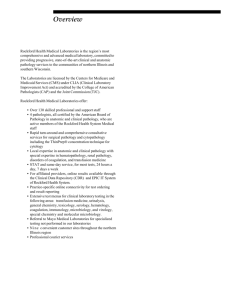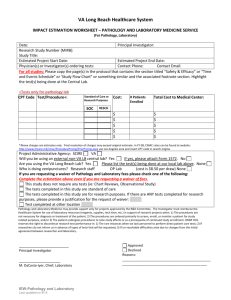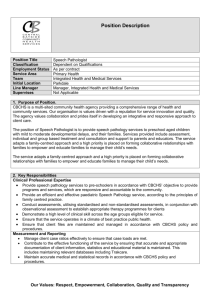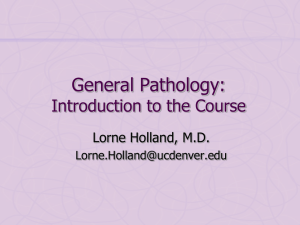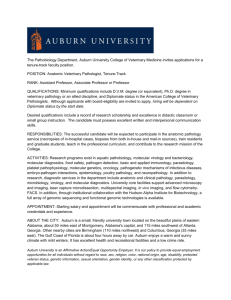LAB & AP merging: proposed strategy and process Why are we
advertisement
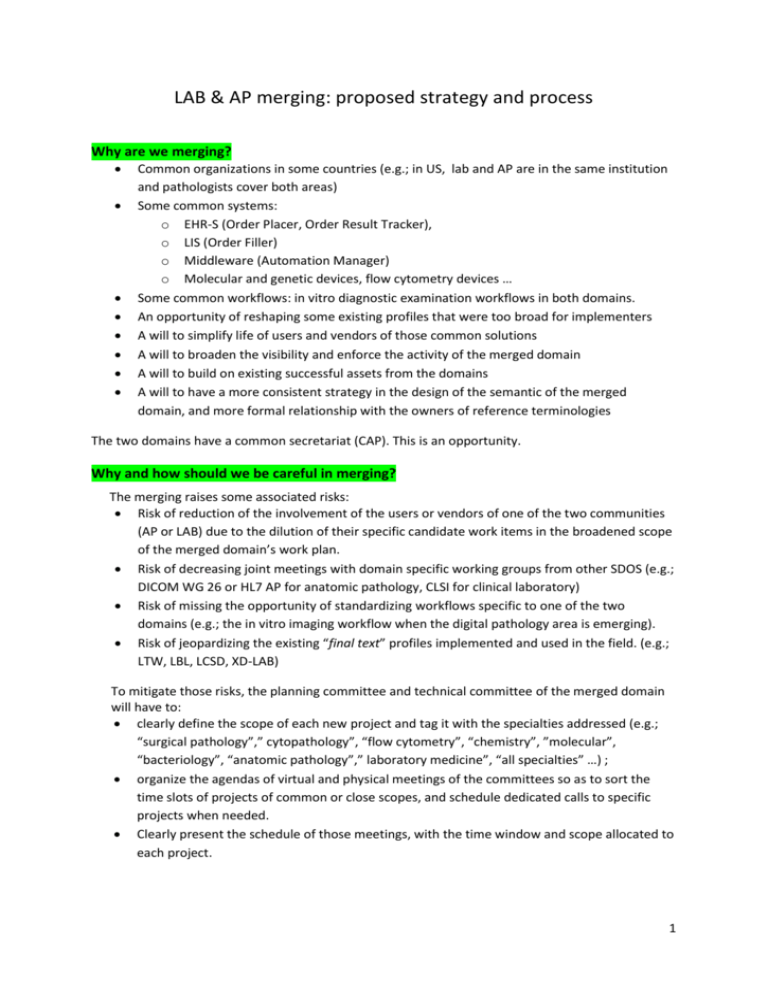
LAB & AP merging: proposed strategy and process Why are we merging? Common organizations in some countries (e.g.; in US, lab and AP are in the same institution and pathologists cover both areas) Some common systems: o EHR-S (Order Placer, Order Result Tracker), o LIS (Order Filler) o Middleware (Automation Manager) o Molecular and genetic devices, flow cytometry devices … Some common workflows: in vitro diagnostic examination workflows in both domains. An opportunity of reshaping some existing profiles that were too broad for implementers A will to simplify life of users and vendors of those common solutions A will to broaden the visibility and enforce the activity of the merged domain A will to build on existing successful assets from the domains A will to have a more consistent strategy in the design of the semantic of the merged domain, and more formal relationship with the owners of reference terminologies The two domains have a common secretariat (CAP). This is an opportunity. Why and how should we be careful in merging? The merging raises some associated risks: Risk of reduction of the involvement of the users or vendors of one of the two communities (AP or LAB) due to the dilution of their specific candidate work items in the broadened scope of the merged domain’s work plan. Risk of decreasing joint meetings with domain specific working groups from other SDOS (e.g.; DICOM WG 26 or HL7 AP for anatomic pathology, CLSI for clinical laboratory) Risk of missing the opportunity of standardizing workflows specific to one of the two domains (e.g.; the in vitro imaging workflow when the digital pathology area is emerging). Risk of jeopardizing the existing “final text” profiles implemented and used in the field. (e.g.; LTW, LBL, LCSD, XD-LAB) To mitigate those risks, the planning committee and technical committee of the merged domain will have to: clearly define the scope of each new project and tag it with the specialties addressed (e.g.; “surgical pathology”,” cytopathology”, “flow cytometry”, “chemistry”, ”molecular”, “bacteriology”, “anatomic pathology”,” laboratory medicine”, “all specialties” …) ; organize the agendas of virtual and physical meetings of the committees so as to sort the time slots of projects of common or close scopes, and schedule dedicated calls to specific projects when needed. Clearly present the schedule of those meetings, with the time window and scope allocated to each project. 1 Which assets are already recognized as sharable/shared between the two domains? Final text profiles from LAB: o LAW (Analytical Workflow) o Sub-templates of XD-LAB (CDA lab report): lab observation, specimen collection procedure, clinical observation, specimen collector, ordering provider, performing lab, result interpretor/validator … reused in the APSR profile from AP. o LCSD (distribution of the test catalog) Trial implementation profiles from LAB already updated to cover AP needs o ILW (Inter-laboratory subcontracted orders) Trial implementation profiles from AP which could be reengineered to extend their scope to LAB: o APW (needs to be split into profiles: APW & In vitro imagining): the in vitro imaging is sharable with the LAB domain o APSR (Anatomic Pathology Structured Report)(needs to be updated, new name Pathology Structured Report) : includes a list of organ-specific observations for molecular biology Profiles from LAB in building phase, which could extend their scope to AP: o LSH (specimen handoff between robotic transportation and laboratory device) o LDA release 2 (operations of perianalytical devices) o LCC (communication between lab and ordering physician, related to order & results) How should we proceed? Keep the Domain Coordination Committee (DCC) informed of our process o Mary Kennedy informs Chris Carr regularly on the ongoing process (Note: subsequent to meeting, Mary Kennedy presented proposal to DCC. DCC was in favor and approved of our proposed process) o Riki provides updates as needed on subsequent DCC conf calls Establish the composition of the co-chairs of the merged domain o 4 co-chairs position for the LAB & 2 co-chairs position for the AP. o This organization preserves the representation of the anatomic pathology (AP) community in the merged domain. Specific needs of this community will be still promoted by 2 dedicated (planning & technical) AP co-chairs within the merged domain. Step one: Agree formally on the decision to merge o Elaborate a “merger proposal” to be discussed and finalized during next conf call and then to be broadcast to both domains for a formal vote. o Rationale for merger to be presented to both domains before voting process o Expect the vote to merge will be in July or August after conference call discussions o If the result of the vote is negative, then the process stops. o Otherwise, starts the transition period: All the existing planning and technical cochairs of AP & LAB keep their position of co-chair during this period. o Candidate name for the merged domain: PALM (Pathology and Laboratory Medicine) Step two: Launch a set of candidate projects of common profiles such as “pathology structured report”, “in vitro imaging” … following the normal process http://wiki.ihe.net/index.php?title=Profile_Proposal_Process: o Call for profile proposals o Submitters send their proposals using the Brief proposal template 2 o Planning committee (led by its current AP & LAB cochairs) organizes the selection of the short list of projects, based on the brief proposals. o Technical committee (led by its current AP & LAB cochairs) organizes the technical evaluation of the candidate projects, based on a detailed proposal submitted by the owners according to the Detailed proposal template. The criteria are: project backed by active users in the field, available editor(s) for the profile, established standards usable, several vendors willing to implement. o Final profile selection for the first cycle of the merged domain o The work on the selected profiles is scheduled. Step three: Cochair elections (staggered) o o Half of the positions of AP technical and planning and of LAB technical and planning open to ballot end 2015 or early 2016. This first election ends the transition period. Second half at some point in 2017 3

